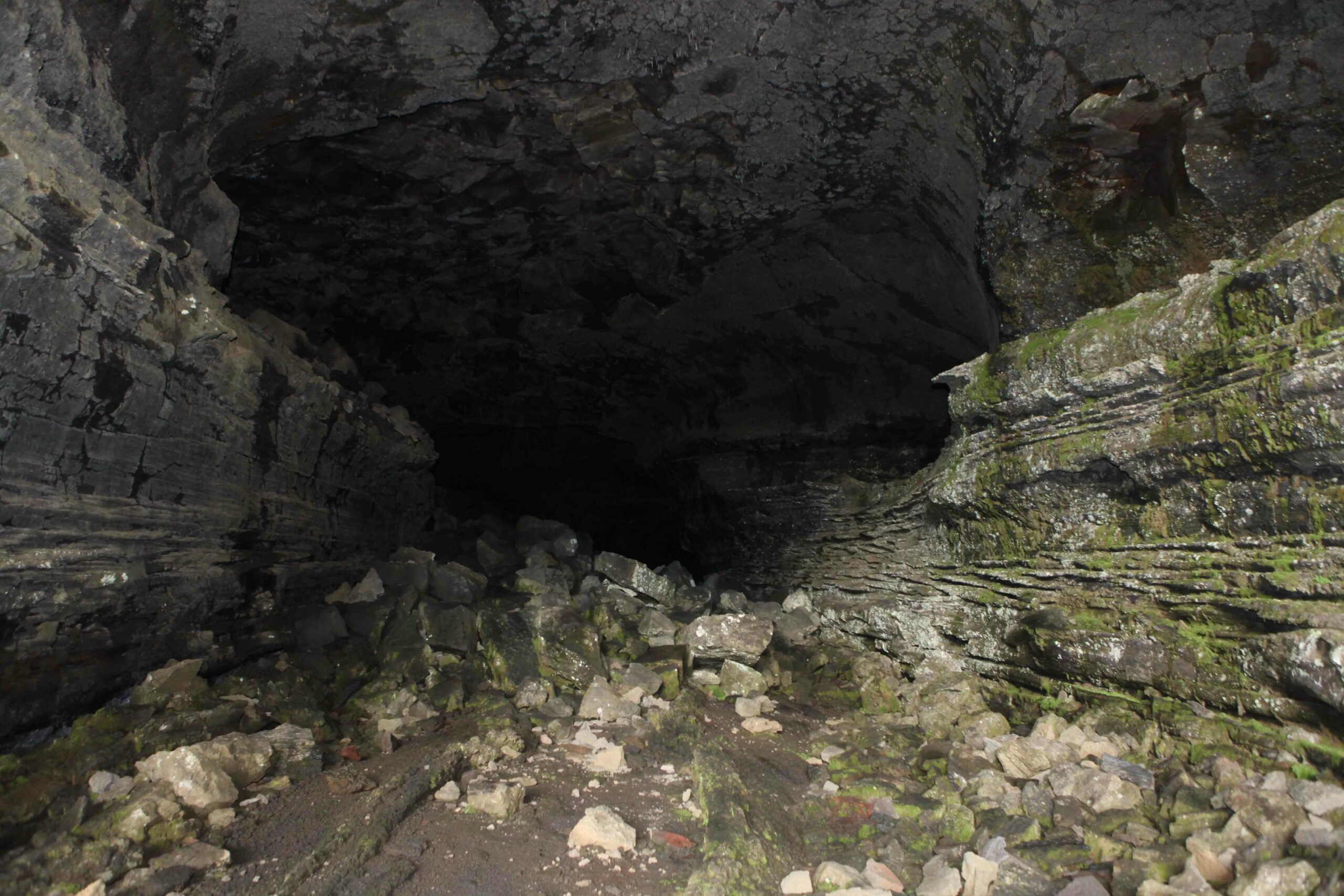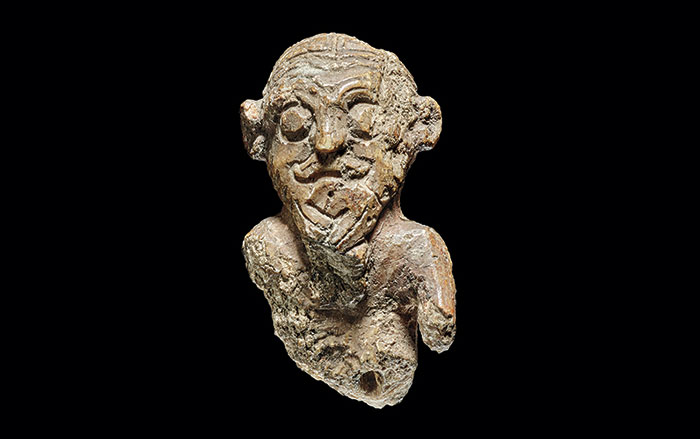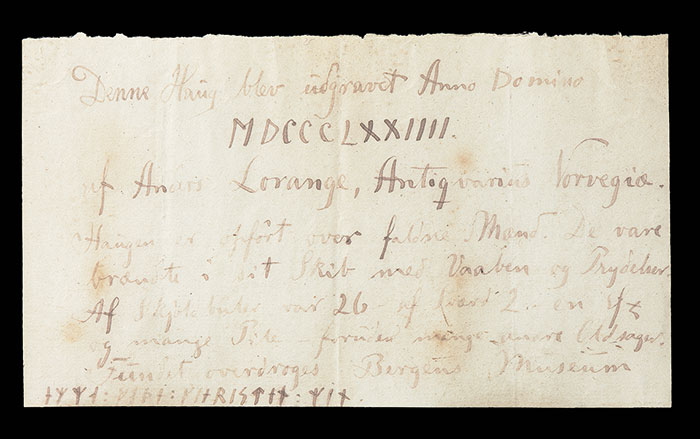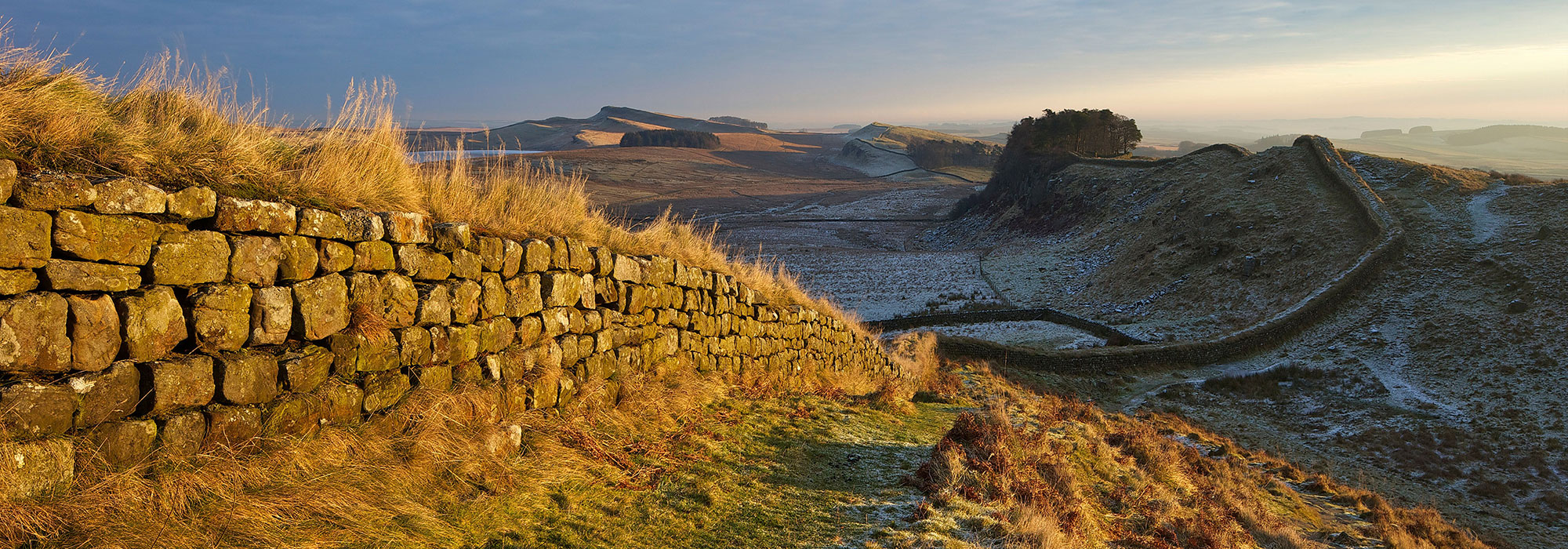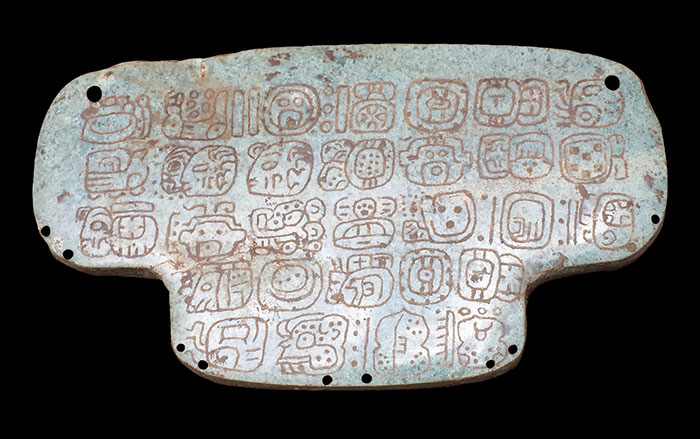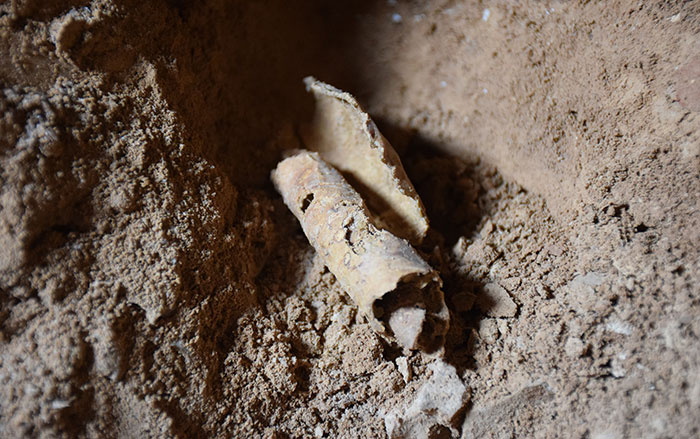The Hallmundarhraun lava field—basalt dark, with great swells and a froth of white moss—looks like a stormy sea whipped into a frenzy and frozen in place. It begins under the Langjökull glacier in mountains to the east and winds some 30 miles to Hraunfoss—literally, “Lava Falls”—where a crystalline river of meltwater pours directly from its wide, stony face. It’s very Icelandic: fire and ice, water and stone. When the lava flowed at the end of the ninth century, shortly after the Vikings arrived on the island, it was probably the first volcanic activity of its kind that northern Europeans had ever witnessed. Those early residents of western Iceland may have heard eruptions, seen a fiery glow on the horizon, and tracked its spread across the landscape, a spread that ultimately consumed around 90 square miles.
Hallmundarhraun, just a few hours’ drive from Reykjavík, is riven with lava tubes which form when fresh molten rock flows through an existing field of cooled lava. Over time, the ceilings of some of these tunnels partially collapse to form caves. There are some 500 across Iceland, and around 200 hold evidence of human occupation. One of these caves is Surtshellir, part of a lava tube complex that is Iceland’s longest, at more than two miles. It is named for Surtr, the elemental fire giant of Norse mythology, the “scorcher” or “blackener,” ruler of Muspelheim, who will kill all gods and life at the end of time. Inside is one of the more enigmatic archaeological sites on the island.
Until one is almost directly on top of Surtshellir’s entrance, an amphitheater-shaped depression, the arrested turbulence and uniform darkness of Hallmundarhraun conceals it. But the cave is no minor feature. It is giant-scaled, a leviathan’s burrow up to 40 feet in diameter, littered with massive, angular blocks of basalt calved from the ceiling. Around 100 yards into the cave, that ceiling opens to the sky, the result of a collapse centuries ago. Just before reaching this skylight, one encounters, partially buried under boulders from the ceiling, a titanic man-made wall, 15 feet tall and spanning the cave, made up of blocks, each weighing up to four tons. Just past the skylight, two small galleries branch off, one to the left and one to the right. These side caves, Vígishellir (“Fortress Cave”) on the left and Beinahellir (“Bones Cave”) on the right, are the remnants of an older, smaller lava tube bisected by Surtshellir. After one scrambles up a rockfall into Vígishellir, the darkness descends like a shroud. Light is swallowed and incidental sound amplified. Breath hangs in the still, cold, humid air.
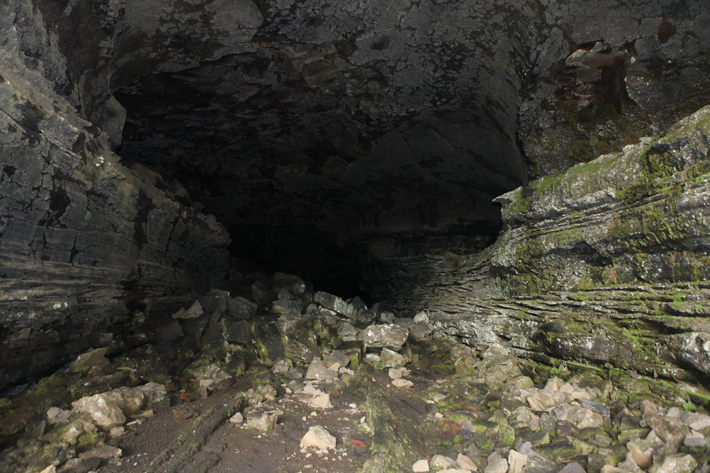
A few yards into Vígishellir is a second man-made structure: an anomalous arrangement of stones, piled a few feet high to form an oval enclosure, 22 by 11 feet. Archaeologists believe it could be the oldest standing Viking structure in the world. Next to it is a pile of animal bones, methodically hacked into tiny pieces. Archaeological sites generally have telltale patterns that show scientists how they were used: domestic activity, craft production, ritual. Surtshellir eludes such clarities. The things it contains—and, more importantly, doesn’t contain—fit some patterns and resist others, and show just how difficult it can be to divine behavior, intent, and even emotion from bits of stone and bone.
The thirteenth-century Landnámabók (or Book of Settlements) describes in detail the earliest habitation of Iceland, beginning around 870. It is the first source to mention Surtshellir by name. It states that a chieftain’s son, Thorvald “Hollow Throat” Thordarson, traveled there across the uninhabitable interior to recite a drápa, or a laudatory poem, to the giant who lived there. It also tells of a group of 18 “cavemen” outlaws who lived in the area centuries before, and a related story appears in the fourteenth-century Harðar saga ok Hólmverja, though neither places them specifically in the cave. In the Sturlunga saga, Órækja Snorrason, illegitimate son of Snorri Sturluson, then Iceland’s most powerful chieftain, was captured in 1236 and taken to Surtshellir, where he was blinded, castrated, bound “on the top of the fortress,” and left for dead (though he survived the ordeal). A later folk story tells of 18 heretical student priests who took refuge in the cave and turned to livestock theft, kidnapping, enslavement, rape, and murder. The dire reputation of Surtshellir increased through the centuries, and was cemented in the Hellismanna saga, a nineteenth-century work of fiction that brought many of the outlaw stories together.
The site deep in Surtshellir—the enclosure in the side cave Vígishellir—was first described as early as the 1750s by Icelandic naturalists Eggert Ólafsson and Bjarni Pálsson, and was cited again several times after that. Notably, none of these descriptions mention the other built feature, the wall across the main tunnel, which was concealed by some combination of darkness, rockfall, and, once the ceiling collapsed fully, snow drifts.
In 2000, archaeologist Kevin P. Smith, now chief curator of the Haffenreffer Museum of Anthropology at Brown University, was excavating at a nearby site. He and archaeologist and architectural historian Guðmundur Ólafsson of the National Museum of Iceland encountered tourists in the small town of Reykholt, once the chiefly center of Snorri himself, who told of the bones they had taken as souvenirs from Surtshellir. “It’s a very long tradition,” says Ólafsson. In the museum collection, there is a large piece of bone collected there by a couple on their honeymoon in 1915—conveniently engraved with the details.

A few days later, Smith and Ólafsson visited the enclosure and bone pile in Vígishellir. “I was shocked to learn that there had never been an archaeological survey,” says Smith. The next year they returned with a team to map Vígishellir and excavate part of the bone pile. It was also the first summer that snow drifts melted back enough to expose the wall in the main part of the tunnel, which proved to be the largest known Viking Age stone structure in Iceland.
The other lava caves in Iceland with evidence of human occupation usually show signs of brief, transient use. Surtshellir is different. “It’s a complicated cave,” says Smith. “It’s got a lot of interesting stories in it.” There is the enclosure in Vígishellir, rough but sturdy. It resembles in shape a Viking-era hall, with an opening, or doorway, on each of its longer sides and three shallow niches built into the walls. In 2001, the bone pile next to it was just a few inches deep and several feet around. It appears that the bones had been thoroughly smashed, perhaps to extract every bit of marrow, a pattern not often seen in Iceland. But, surprisingly, they were not burned or scorched by a cooking fire. Staining on the wall and fragments embedded in cracks show that the pile—before tourists and travelers got to it—had been a couple of feet deep and 12 feet around, perhaps representing the remains of up to 200 animals. The archaeologists excavated a portion of the pile and catalogued 7,500 fragments, mostly from sheep and goats, but also cattle, pigs, and horses. Radiocarbon dates and the age of the lava flow put the bones at around 890–930, soon after the arrival of the first migrants from Scandinavia.
The other structure in Surtshellir, the large wall, adds to the mystery. It is easily overlooked when initially exploring the cave, but once distinguished from the later rockfall, it is unmistakable. Its sheer face runs 40 feet across, a formidable barrier to movement through the cave in either direction. Because there is no passage through it, anyone wishing to access the deeper interior of the cave and the enclosure there would have to scale it. Building the wall was surely a communal undertaking—by hand, in complete darkness. “This is almost certainly the ‘fortress’ wall on which Órækja, Snorri’s son, was blinded, castrated, and left to die,” says Smith.
Smith and Ólafsson’s initial interpretation hewed to the cave’s local reputation. “It takes quite a lot of work to put up those stones,” says Ólafsson. “If you have a group of youngsters with testosterone and needing something to do, I think this would be a perfect place to have a youth gang.” Under this theory, the cave would indeed have been the residence of a band of young outlaws who raided local farms for livestock and deposited the bones in a pile. The wall would have been built for defense, the enclosure a sort of “home” to make the space more livable, Ólafsson suspects. As time passed after their initial explorations, however, Smith began to have doubts about the hypothesis.

Surtshellir is a place without equivalents, and would have been very, very difficult to live in. The enclosure in Vígishellir is around 800 feet from the entrance. Before the ceiling collapsed, it was far beyond the reach of natural light. Anyone living there would need fire for heat, light, and cooking. They would need a latrine area in the cave to spare them dangerous passage through the darkness and over the massive wall. The cave is damp but has no stream, so the outlaw residents also would need means to collect, transport, and store water. Finally, though the written sources are not strictly reliable, many refer to 18 outlaws. That’s a lot of people to be making use of the small, room-sized, short-walled “house.” “It’s not big enough for 18 people to do anything in,” says Smith.
In 2012, Smith, Ólafsson, and others returned, with funding from the National Science Foundation and Iceland’s heritage agency, to test a new 3-D modeling system developed at Brown. The cave environment made modeling difficult, but Smith saw an opportunity to look for more evidence of long-term occupation. During the project, the team chanced upon a Viking Age bead, then another, and pieces of jasper firestarters, all in a delicate, sandy layer running through the enclosure. The next year Smith brought a team back for an emergency excavation and survey.
The archaeologists found few of the additional signs of occupation Smith was looking for. Little to no soot on the walls and ceiling. No hearth or food preparation tools. No phosphate-rich areas to indicate a latrine. No water collection or storage system. No additional structures. Though absence of evidence is not evidence of absence, the apparent lack of any of these features bolstered Smith’s suspicions. The survey did find the remains of six additional, smaller bone piles—now more or less picked clean—near the enclosure, in the main tunnel, and in the second side gallery, Beinahellir. The bone fragments were contemporaneous with the main bone pile, deposited over a span of 80 to 100 years. That is a long time for an outlaw occupation that left scant evidence, especially during a time when such careers were more often measured in months or seasons rather than decades.
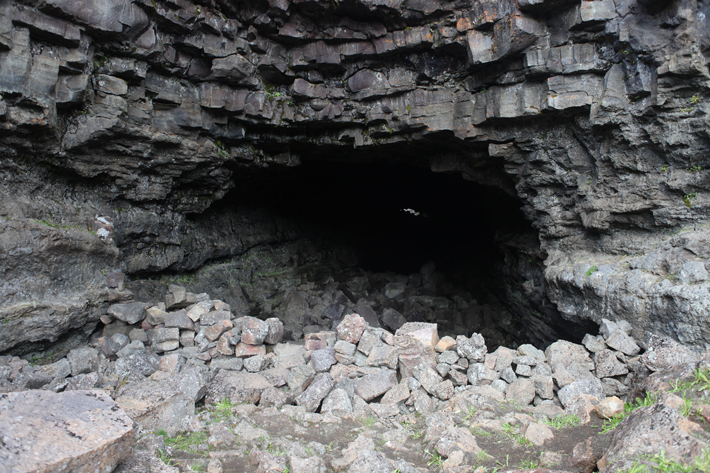
The sandy layer held a collection of glass beads near the opening in the enclosure that faces the deeper recesses of the cave—“one of the largest assemblages of beads at any site in Iceland other than burials,” says Smith. They came in an unusually restricted set of colors: green, blue, and yellow. Around them were small flecks of orpiment, a valuable arsenic-based yellow pigment not otherwise found in Iceland at the time. The beads and orpiment may have been part of an object of some value. There were also burned bone fragments, clearly separated from the large, unburned bone pile. “There was a strangely divided treatment of bone,” Smith says. Within the structure were more jasper firestarters—the Viking equivalent of matches, in this case burned by intense heat—from all over western Iceland, in a variety of colors, but notably not the black jasper from the closest known source. It appears that the enclosure had been host to fires after all, but only episodically.
And, in the center of the enclosure, the archaeologists found a lead cross, and then three other lead pieces. They had been pecked and gouged, suggesting they were used as official weights. Smith believes they comprise a complete set, as they add up to 26 grams, a weight standard that Vikings used not for commerce but for legal proceedings, such as the manumission of a slave or compensation for injury or murder. He thinks that they were not dropped by outlaws, but rather placed there (and not burned) deliberately—to end a tradition of ritual offerings around the time Christianity came to Iceland. “It has closing deposit written all over it,” he says.
The strange artifacts and patterns of color and origin, to Smith, echo this more mystical explanation. In the Landnámabók, it is not outlaws that Surtshellir is explicitly tied to, but the poem of praise to the giant. Traditionally, such poems were powerful incantations, still remembered, in this case, hundreds of years after the island-wide conversion to Christianity.

Smith’s theory is that the cave was the site of rituals dedicated either to keeping Surtr in or to supporting Freyr, a Norse god of fertility and agriculture who opposes Surtr. The enclosure, in addition to resembling a Viking hall, could also be interpreted as a ritual stone boat, related to the mythology of giants. The domestic animals may have been sacrificed as a call to Freyr and placed in a series of piles as a barrier across the cave—like the wall itself. The colors of the beads are also associated with Freyr, and the absence of black beads or jasper is interesting, as the color is tied to Surtr. The labor involved and the value of the remains suggest to Smith that the rituals were organized at the chieftain level. “The punch line is that it worked,” he says. “The volcano never erupted again.”
The National Museum’s Ólafsson doesn’t appear convinced just yet. While he acknowledges that the site is unusual and complex, he thinks that occupation by some fringe group remains the most likely explanation, supported by cultural traditions. “In my opinion, that story gives the best explanation of all the finds, but it seems that it’s much more complicated than we thought in the beginning,” he says. “I don’t think we have the answer yet.”
A ritual history and a legacy of outlaws need not be mutually exclusive. Both engender a frisson of fear, the taboo, the unknown, transgression, destruction. It’s not hard to imagine that a place thought to be the gateway to Muspelheim, the door through which the blackener would come to claim time itself, would become home to stories of debased priests, torture, and gangs who terrorized the countryside. During the 600 years between the medieval and modern periods, Surtshellir was more or less unvisited and perhaps even off-limits. Whether associated with giants or outlaws, it was threatening. The place where these narratives overlap—mythical, apocryphal, historical, archaeological—at least conveys a bad feeling. It’s darkness, and in Surtshellir, it is consuming.


